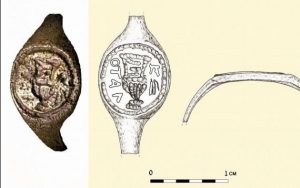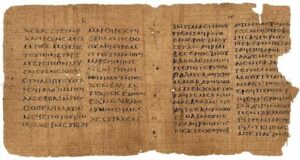Have archaeologists re-discovered the ring worn by Potius Pilate at his sentencing of Jesus?
Excitement surrounds a 2,000-year-old copper alloy ring bearing the inscription “of Pilatus” as it appears to be the second artifact testifying to the existence of the infamous Pontius Pilate.
The ring was actually unearthed 50 years ago but overlooked until recently, when it was cleaned revealing the name of the ruler.
Pilate, a Roman prefect who ruled the Roman province of Judaea, from circa 26–36 AD, is mentioned in several accounts in the New Testament, as having ordered the trial and crucifixion of Jesus.
The ring was first found among hundreds of other artifacts in excavations during 1968–1969 directed by archaeologist Gideon Foerster. Those digs were at a section of Herod’s burial tomb and palace that was used during the First Jewish Revolt from 66–73 AD.
The site is so extensive that it is still being excavated and current dig director Roi Porat recently asked that the engraved copper sealing ring be given a thorough laboratory cleaning and scholarly examination.
The scientific analysis of the ring was published in the biannual Israel Exploration Journal last week, by the 104-year-old Israel Exploration Society.
Headlines in Israel’s newspapers read,“Ring of Roman Governor Pontius Pilate Who Crucified Jesus Found in Herodion Site in West Bank.”
At the center of the ring is an engraved “krater,” a large wine vessel, which is encircled by small, now “partly deformed” Greek letters spelling out “of Pilatus.” Interestingly, according to DiSegni, the direction of writing for the two words is different, and one word is “disturbed by a defect” in the metal.
Could this “Pilatus” be the Pontius Pilate described in the New Testament?
Archaeologist Porat told The Times of Israel, “It was important to publish a careful scientific article but in practice we have a ring inscribed with the name Pilate and the personal connection just cries out,” said Porat.
While it is unclear exactly when the ring was forged, it was discovered in an eastern garden built on a porch in a room constructed of secondary building materials. The room offered an archaeological layer that dates to no later than 71 AD because that is the time frame when the Romans destroyed Jerusalem and the Second Temple. In addition to the ring, “a wealth of finds” include an array of glass, writing materials, pottery and decorated mud stoppers, and “an abundance” of metal artifacts, such as iron arrowheads, a large number of First Jewish Revolt coins, and this copper alloy sealing ring.
So whose ring was it?
There’s a lot in a name
While the name Pontius was common for Romans during the Second Temple, Pilate was not. The only accepted historical artifact testifying to the life of the Roman prefect is predicated on this unusual surname.
A stone with a circa 30 CE Latin dedicatory inscription of Pontius Pilate was discovered in Israel’s Caesarea port in the 1960s. (AP Photo/John Bazemore)
The “Pilate Stone” is a massive inscribed building block uncovered in 1961 excavations at a theater or arena at Caesarea along the coast in northern Israel. According to a September 2017 Biblical Archaeology Review article by Lawrence Mykytiuk, “New Testament Political Figures Confirmed,” it was found face-down and had been modified for its secondary use as a step.
The stone contains four lines of text, two of which read, “[Po]ntius Pilate … [Pref]ect of Juda[ea].” According to Mykytiuk, the best estimated dating of the stone places it between 31 and 36 AD. The scholar writes that “the family name Pontius was common in central and northern Italy during that era, but the name Pilatus was ‘extremely rare.’” citing the International Standard Bible Encyclopedia.
“Because of the rarity of the name Pilatus, which appears in full, and because only one Pontius Pilatus was ever the Roman governor of Judea, this identification should be regarded as completely certain,” writes Mykytiuk.
Histoirans are unsure if someone of Pontius Pilate’s status, the powerful and rich prefect of Judaea, would have worn a thin, all copper-alloy sealing ring but it is not to say he did not.
“There is no way of proving either theory 100% and everyone can have his own opinion,” said Porat. Regardless, “it’s a nice story and interesting to wrap your head around.”
Whether the ring is THE ring worn by Pilate himself, or someone under his command like a scribe, it does give credibility to the fact that Pilate did exist as mentioned in the New Testament.
–Archaeology News
 Metro Voice News Celebrating Faith, Family & Community
Metro Voice News Celebrating Faith, Family & Community 











